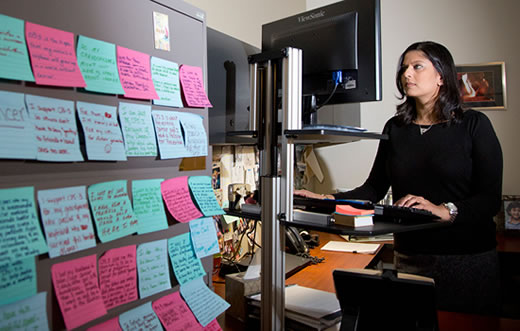Alpa Patel wants you to stand up. With a Rollins School of Public Health MPH, the strategic director of the Cancer Prevention Study (CPS)-3 for the American Cancer Society, Patel has focused her research on the role of physical activity in cancer prevention and obesity as a risk factor for cancer. More recently, she has begun looking at possible links between sitting and cancer risk.
That's right. What you are probably doing right now as you read this article may be increasing your risk for developing diseases, including cancer. And you're not alone. Between working at a desk, watching TV, and driving around town, the average American spends more than eight hours a day sitting.
In an earlier study, Patel found that people who sat a lot, particularly women, tended to die earlier. Women who sat for more than six hours a day were 37% more likely to die during the 13 years of the study than those who sat for less than three hours a day. Men who sat more than six hours a day were 18% more likely to die than those who sat less than three hours. She estimates two years of life can be gained by reducing sitting to less than three hours a day.
Surprisingly, this level of risk applied even to people who religiously went to the gym but sat at desk jobs the rest of the day—people Patel likes to call "active couch potatoes."
Studies have shown that sitting for long periods of time, even when combined with meeting public-health guidelines on physical activity, is associated with high blood pressure, elevated lipid levels, chronic inflammation, and abnormal cholesterol—any of which could contribute to an increased cancer risk.
One study has already been published showing an association between the amount of time spent sitting and the risk for multiple myeloma. Another study looking at the association with other forms of cancer is currently being reviewed for publication, so Patel cannot yet discuss those findings.
And even when she can, she will have more questions than answers. "These are observed associations, and there is not yet a full understanding if the culprit is sitting time or if that could be a proxy measure for something else," says Patel. "It may be that sitting time, especially when watching TV, is associated with unhealthy snacking, which is why it is associated with elevated cancer risk. The bottom line is, we are still trying to understand what all of this means."
Patel was drawn to her current line of research by a personal interest. "I was one of those active couch potatoes," says Patel, who is an adjunct faculty member in epidemiology at Rollins. "I went to the gym regularly and did twice as much as the minimum level of recommended physical activity. I ate well. But I had a little weight that I wanted to get off that I simply could not."
So Patel started thinking about how she spent the 15 hours of the day when she wasn't at the gym or sleeping. She got a pedometer and tracked her steps to see if she was getting close to the recommended 10,000 steps a day. She wasn't. When Patel didn't go to the gym, she logged about 1,800 steps a day. "I was shocked," she says. "I had no idea I was that sedentary."
Patel made what she considers minor changes in her day-to-day activities. She continues to watch the same amount of TV, but instead of curling up on the couch, she stands and folds laundry or does small chores as she watches. She got rid of the printer in her office so she walks down the hall anytime she prints anything. She now works at a sit-stand desk and tries to do all her work on her feet. In five months Patel has lost the 20 pounds she had been trying to shed.
"It does not take the place of being physically active, but for the two-thirds of our population who are not meeting physical activity guidelines, there is tremendous public health value in saying, 'If you don't do anything, there is benefit in simply standing up and starting to move,'" says Patel.

